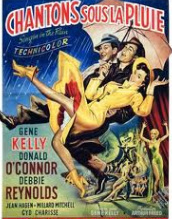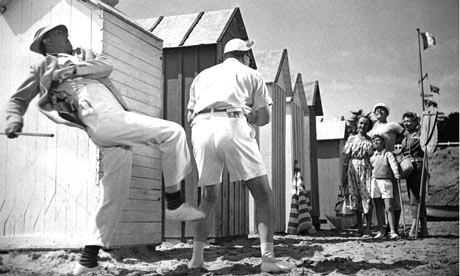The Artist (2011) Dir: Michel Hazanavicius
How The Artist Is Indebted to Other Movies:
An intermittently inventive movie inspired by other cinematic sources.
Some of The Artist 's Key Cinematic Influences:
The Artist is indebted to these comic and cinematic influences:
Pierre Étaix: forgotten master of (almost) silent comedy
The influence of French movie director Pierre Étaix (born 1928) is visible in almost every scene of The Artist. Étaix's life is worthy of a movie itself. Not only has he been a director and a script-writer. He has also been a clown, a graphics artist, an actor, an illusionist, a circus performer,and worked in cabaret and variety. Étaix won an Oscar in 1962 for best short feature film -Happy Anniversary. He has also written several books on cinema, including works on Buster Keaton and jerry Lewis. His work has influenced Fellini, Jerry Lewis and, recently, Hazanavicius.
Étaix made a handful of comedy features during the 1960s. They include The Suitor, YoYo, and So Long as You're Healthy. LIke Tati, Étaix loved Hollywood's golden age silent comedies, with its great comics and directors such as Harold Lloyd, Chaplin, Laurel and Hardy and Keaton. His own comedies, like The Artist, incorporate features of golden age comic styles and techniques.These include physical dexterity, notably flexibility of limb and features, employed to comic effect. Many of the gags are of the slapstick type, involving chases, collisions, amazing avoidance of accidents as well as wayward objects, often including animals and/or children. There are also chain gags, one mishap inevitably causing an escalation of falls, smashes, and embarrassing outcomes. Carefully selected camera angles also add to the comic, sometimes surreal effect. His films also feature an animal or two, stock comic figures,pretty ingenues, and a male lead struggling to gain or regain happiness - all features of The Artist. But Étaix's comedies are tauter and better-paced than Hazanavicius' film, which drags during its second half. The clip below from YoYo shows just how much of Étaix' cinematic and comedic style is used in The Artist. Jacques Tati's near-silent cinema comedies Jacques Tati -the 'Don Quixote of cinema'.
Étaix's film career began in 1954 when he started to work for one of the giants of cinema comedy, Jacques Tati, who was then in pre-production mode on his famous comedy Mon Oncle. He spent four years with Tati, who worked in the silent film comedy tradition, using minimal dialogue. Étaix worked preparing comic set-ups, as a draughtsman and then as assistant director on the film itself.
Like Étaix, Tati made few films: only four in thirty years.He didn't start making films until he was forty, having spent fifteen years as a music hall performer and an actor.His first film , Jour de Fete, relied on silent comedy routines but used sound effects as comic counterpoints. This feature was employed more extensively in his next film, Mr Hulot's Holiday, which introduced a beloved stock French comic figure, modelled on Chaplin and Keaton ˆThe film on which Étaix worked with Tati, Mon Oncle, won an Oscar. It comically contrasted Hulot's life in a small, traditional French village and his sister's life in her modern, Americanised apartment in a new city nearby. The affectionate mood of these three films, with their moments of sllpstick comedy,sympathetic characters, meticulously timed set-pieces and brillant use of sound effects can also be seen in The Artist. The sequence below from Mr Hulot's Holiday illustrates the use of music and sound, and the clever construction of a pay-off gag. |
|















